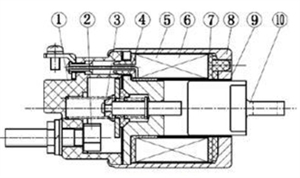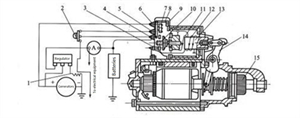- English
-
EnglishDeutschItaliaFrançais한국의русскийSvenskaNederlandespañolPortuguêspolskiSuomiGaeilgeSlovenskáSlovenijaČeštinaMelayuMagyarországHrvatskaDanskromânescIndonesiaΕλλάδαБългарски езикGalegolietuviųMaoriRepublika e ShqipërisëالعربيةአማርኛAzərbaycanEesti VabariikEuskeraБеларусьLëtzebuergeschAyitiAfrikaansBosnaíslenskaCambodiaမြန်မာМонголулсМакедонскиmalaɡasʲພາສາລາວKurdîსაქართველოIsiXhosaفارسیisiZuluPilipinoසිංහලTürk diliTiếng ViệtहिंदीТоҷикӣاردوภาษาไทยO'zbekKongeriketবাংলা ভাষারChicheŵaSamoa日本語SesothoCрпскиKiswahiliУкраїнаनेपालीעִבְרִיתپښتوКыргыз тилиҚазақшаCatalàCorsaLatviešuHausaગુજરાતીಕನ್ನಡkannaḍaमराठी
E-mail:Info@YIC-Electronics.com
What Is A Solenoid Switch
When an electrical current flows through the coil, the resulting magnetic field either attracts or repels the iron core, causing it to move and either open or close the circuit. This basic working principle enables electromagnetic switches to be utilized in various applications, such as current regulation in circuits, remote control in automation systems, and as essential components in automobile ignition systems. Different types of electromagnetic switches are versatile and can be used in a range of application scenarios.
Electromagnetic switches operate at the intersection of electromagnetics and mechanical engineering. Its basic components include coils and sliders. ABB electromagnetic coils are usually composed of wires wound on insulating sheets. Their functions are determined by their length, cross-section, and materials used. Next, we’ll dive into the core elements of these switches and how they work. Understanding the interaction of these basic building blocks is key to mastering the operation of electromagnetic switches.
The movable part, called the plunger, is a removable iron core. Its size and shape will affect the characteristics of the electromagnet to a certain extent.

Figure 1: Electromagnetic Switch Structure Schematic Diagram
①. Switch Cover
②. Contact Screw
③. Moving Contact Piece
④. Static Iron Core
⑤. Suction and Pull Coil
⑥. Holding Coil
⑦. Coil Skeleton
⑧. Switch Case
⑨. Guide Sleeve
⑩. Moving Iron Core
When current passes through the coil, the direction and intensity of the magnetic field generated changes with the current. This magnetic field either attracts or repels the sliding column, depending on the direction of the current. This movement is the core of the electromagnetic switch operation. Next, we'll see how these theories are applied in practice.

Figure 2: Physical Picture of Electromagnetic Switch
The sliding post is typically connected to a mechanical part of the high-power switch, and the mechanical connection can be threaded, pinned, or otherwise built. The movement of the sliding column triggers the opening and closing actions of the high-power switch, thus controlling the on-off state of the circuit.

Figure 3: Solenoid Start Switch
①. Generator Excitation Coils
②. Switches
③~⑥. Terminal Blocks
⑦. Iron Suction Coils
⑧. Dynamic Contacts
⑨. Static Contacts
⑩. Reset Spring
⑪. Suction Coil (Thick Coil)
⑫. Holding Coil (Thin Coil)
⑬. Movable Iron Core
⑭. Drawing Fork
⑮. Starting Gear
Electromagnetic switches frequently feature four connection terminals for joining to a circuit. Two terminals connect the coil while the other two connect to a high-power switch, enabling circuit control.
Electromagnetic switches have various specific features to cater to diverse fields. How do these types differ in simple and complex applications?
Single-pole switches are fundamental to simple circuits, including those that control household appliances. They have only one operating pole to close or open a circuit. Electromagnetic switches are necessary for more complex, specialized applications.
The electromagnetic switch for the car starter system is crucial. When the vehicle key is turned to start it, the solenoid switch links the battery to the starter motor, which in turn starts the engine. Electromagnetic switches have even more significant applications in industry.
There are many types of electromagnetic switches, each with its own unique application areas. These switches can be roughly classified into several categories.
AC laminated electromagnets have become the first choice for AC circuits due to their excellent reliability and long life.
DC C-type electromagnet has distinctive features: it is very suitable for DC circuits, especially in electronic equipment.
As for DC D-type electromagnets, they dominate high-precision applications, such as printers and CNC machine tools.
Coil electromagnets are undoubtedly the king when it comes to high-current applications, such as in welding machines.
The unique function of rotating electromagnets is to convert rotating motion into linear motion, which is indispensable in automatic mechanical systems.
Electromagnetic switch, the heart of fluid control. It precisely controls the pulse of liquids and gases. Think about automated fluid transfer and pneumatic systems and how heavily they rely on various solenoid valves: direct-acting, pneumatic, two-way, three-way, and even four-way solenoid valves. Multifunctional? Of course. Electromagnetic switches span countless fields. Now, this article will delve into their core application areas.
Electromagnetic switches are almost everywhere. From the electronics to the automotive industry, from factory automation to the appliances in your home, it is quietly playing a role. In the washing machine? It's the one that controls the water flow and the door lock. In high-power circuits, it regulates huge currents and ensures that everything is under safe control. The circuits involved are not limited to industrial equipment but also extend to the entire power system.
Looking at remote control, the function of the electromagnetic switch is even more indispensable. Whether it is remote monitoring, smart home, or other automation systems, it is the driving force behind it. Imagine controlling various devices remotely and conveniently, and there is the shadow of electromagnetic switches behind this.
What about cars? The electromagnetic switch is closely integrated with the car's engine starting system. When you gently turn the key to start the car, it is the electromagnetic switch that uses the power of the magnetic field to connect the battery to the starter motor to start the engine.
The electromagnetic switch, a seemingly simple electronic component, hides extremely complex working principles and multiple functions. How do these tiny components effectively control electrical current and mechanical movement? This article will take you into the world of electromagnetic switches and provide an in-depth analysis of their working mechanisms, types, and differences, and their numerous application scenarios.
You will be amazed by the breadth and depth of this component. In countless application scenarios, electromagnetic switches are not only the core force that promotes the continuous advancement of technology but also provide countless conveniences to society in various fields.
Related Blog
-
Fundamentals of Op-Amp Circuits
December 28th, 2023
In the intricate world of electronics, a journey into its mysteries invariably leads us to a kaleidoscope of circuit components, both exquisite and co... -
How Many Zeros in a Million, Billion, Trillion?
July 29th, 2024
Million represents 106, an easily graspable figure when compared to everyday items or annual salaries. Billion, equivalent to 109, starts to stretch t... -
Comprehensive Guide to SCR (Silicon Controlled Rectifier)
April 22th, 2024
Silicon Controlled Rectifiers (SCR), or thyristors, play a pivotal role in power electronics technology because of their performance and reliability. ... -
CR2032 lithium-ion battery: multi-scenario applications and its unique advantages
January 25th, 2024
The CR2032 battery, a commonly used coin-shaped lithium-ion battery, is essential in many low-power electrical products such as digital watches and po... -
NPN and PNP Transistors
December 28th, 2023
For exploring the world of modern electronic technology, understanding the basic principles and applications of transistors is essential. Although the... -
What is a thermistor
December 28th, 2023
In the realm of modern electronic technology, delving into the nature and working mechanism of thermistors becomes a crucial endeavor. These precision... -
Explore the Difference Between PCB and PCBA
April 16th, 2024
A PCB serves as the backbone of electronic devices. Made from a non-conductive material, it physically supports components while also connecting them ... -
BC547 Transistor Comprehensive Guide
July 4th, 2024
The BC547 transistor is commonly used in a variety of electronic applications, ranging from basic signal amplifiers to complex oscillator circuits and... -
What Is A Solenoid Switch
December 26th, 2023
When an electrical current flows through the coil, the resulting magnetic field either attracts or repels the iron core, causing it to move and either... -
IRLZ44N MOSFET Datasheet, Circuit, Equivalent, Pinout
August 28th, 2024
The IRLZ44N is a widely-used N-Channel Power MOSFET. Renowned for its excellent switching capabilities, it is highly suited for numerous applications,...
Hot Parts
- RT0805DRD07510KL
- TPS24770RGER
- SN75LBC180A
- AD6122ACPRL7
- LTC2448IUHF#TRPBF
- LM2936HVBMA-3.3/NOPB
- HWD2190LTL
- BD8606FV-E2
- MT41K512M8RH-125:E
- 2MBI75L-060
- DX-5R5H473U
- TAP106M050SCS
- ICS3732DG-32LFT
- HY51V7400CT-60
- MT29F2G08ABAEAH4-AATX:E
- 12062A101GAT2A
- CGA4J2X5R1H334K125AA
- CGJ2B2X7R1C332K050BA
- S1JHE3_A/I
- TPS75201QPWPR
- MB86295SPB-GS-E1
- APA2057ARI-TRL
- UPD808520GM-611-GAA-A
- D2116BG20VH8S
- 1812CC562KAT3A
- P80C528EFB
- DS8113-RNG
- MB39C313BES-E1
- FDS86240-NL
- LQW18ANR39G8ZD
- CM1210-02SC
- CM900DXL-24A
- IC42S16400-7BG
- SKM800GB126D
- F741529AGHHR
- MC33790EG1
- C4532X7R2A155M230KA
- AAT1102-M-T
- ST10F269-BQ3
- GRM0335C1H3R7BA01D
- ATF16V8B-15JU
- VI-26T-CX
- UPC4074C
- TMS570LS0714APGEQQ1
- TSUMV56RUET-00A0
- XCS30XLPQ240A
- MB10S-10
- LTC4012CUF-PBF












